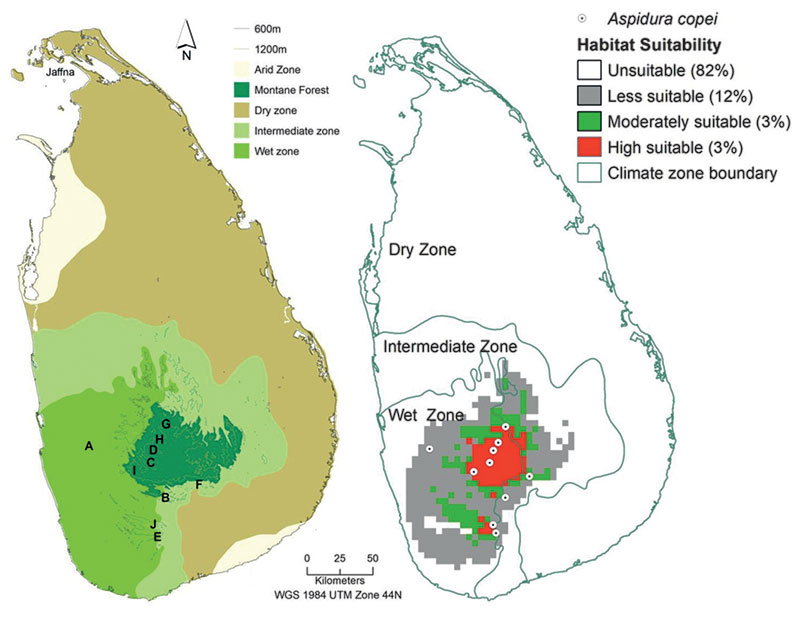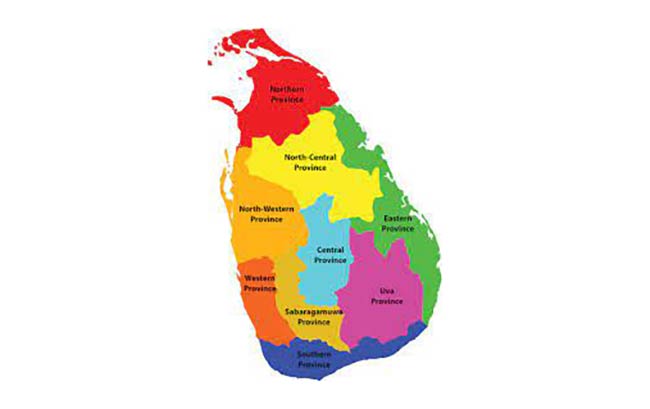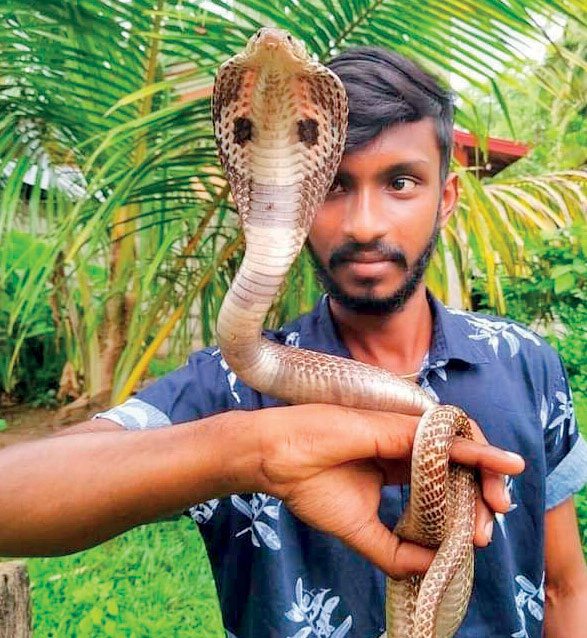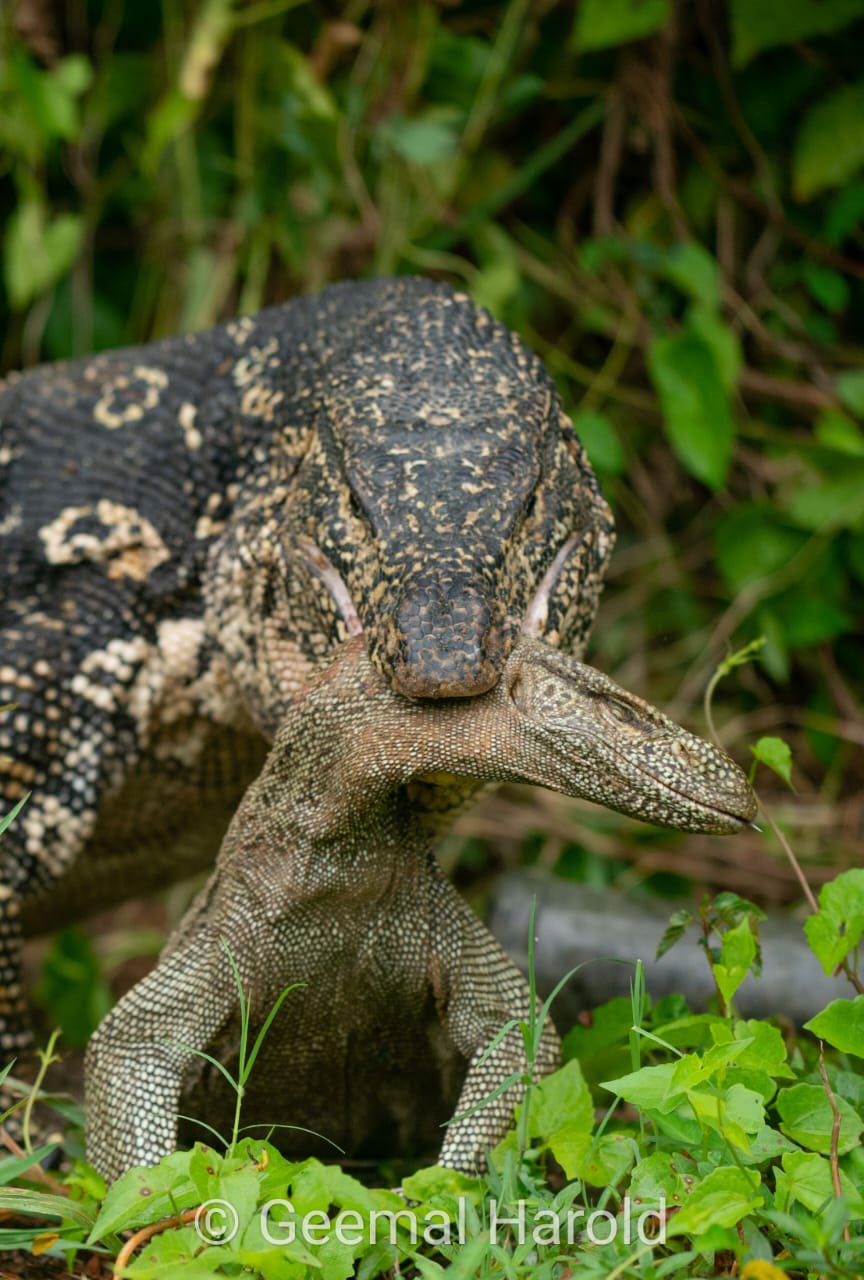Features
A serpent resurrected: Rediscovery of Cope’s Rough-sided snake

By Ifham Nizam
For nearly a century, the Cope’s Rough-sided Snake (Aspidura copei) seemed to have vanished from the face of the earth. Last seen in the early 20th century, this elusive reptile was feared extinct, a casualty of habitat loss and human encroachment. However, a recent discovery has brought hope to conservationists and herpetologists alike.
The rediscovery of A. copei is a significant milestone in the field of herpetology. This species is one of the rarest members of its genus, with a narrow distribution and limited sightings. Its unique physical characteristics, including its distinctive coloration and keeled scales, make it a fascinating subject of study.
The researchers found that A. copei prefers habitats with dense canopy cover and cooler temperatures. They also observed that the species is threatened by habitat loss, deforestation, and human activities.
The scientific research team comprises of Anusha Atthanagoda of Ministry of Public Administration, Sajith Kumara of Kumbukawaththa, Gonapala, Dr. Anslem de Silva of the Amphibia and Reptile Research Organization, Buddhika Madurapperuma of the Department of Botany, The Open University of Sri Lanka, Majintha Madawala of the Victorian Herpetological Society, Australia and Suranjan Karunarathna of the Nature Explorations & Education Team.
Karunarathna, a member of the research team, shared with The Island that while the genus Aspidura includes nine species, A. copei stands out as one of the rarest. “Species-level molecular phylogenetic analyses have confirmed that all species within this genus are distinct,” said Karunarathna. However, he added: “A. copei has the narrowest distribution and is known from just 10 localities in the island’s submontane forests.”

Aspidura copei from Haldummulla, Sri Lanka (note dark blotches on the dorsum). Photos by Anusha Atthanagoda
A Rare Jewel of Sri Lanka’s Forests
First described in 1864 by Albert Günther, A. copei has remained largely a mystery. The original specimen, held at London’s Natural History Museum, lacked precise location data, but over the years, researchers have managed to identify several other specimens in international museum collections. “Despite extensive research, the snake remains elusive and difficult to study in its natural habitat.”
What makes A. copei particularly fascinating is its adaptability to a burrowing lifestyle. With a pointed snout and subcylindrical body, this snake thrives in dense, humid forests where it hunts for earthworms and small insects. Unlike its more widely distributed relatives, A. copei seems to be tied to the moist, high-elevation habitats of Sri Lanka’s central wet zone.
According to the MaxEnt Model predictions, the species is best suited to the tropical submontane and montane forests of South Central Sri Lanka. This fragile ecosystem, rich in biodiversity, is one of the last refuges for many of the island’s endemic species.
Habitat Loss and Fragmentation
However, these forests are under severe threat. The expansion of tea plantations, coupled with human settlements, has led to significant habitat degradation, fragmentation, and loss. “We observed many threats during our study, from tea land expansion to the development of human settlements,” said Karunarathna.
The researchers fear that these pressures could push A. copei and other species to the brink of extinction. Already confined to a few isolated localities, any further encroachment on its habitat could have devastating consequences.
Guardians of the Ecosystem
The genus Aspidura, commonly known as rough-sided snakes due to the keeled scales along their bodies, represents an ancient lineage within the snake subfamily Natricinae. These snakes, while small and often overlooked, play an essential role in maintaining the health of forest ecosystems. They help control insect populations and contribute to the overall balance of the food web.
Their diminutive size—ranging from 150 to 700 mm—belies their ecological importance. “They are often found in areas with humus-rich soil and moist conditions, even in the lowlands,” said Dr. Anslem de Silva, one of the study’s co-authors. “But they seem to thrive in the wet montane zones, which are increasingly under threat.”
Species like A. copei act as indicator species, meaning their health reflects the state of their environment. A decline in their population could signal broader ecological issues, such as declining forest health or increasing environmental degradation.

Map 1:The current distribution of Aspidura copeiin Sri Lanka, (A). Avissawella, (B). Balangoda, (C). Dickoya, (D). Dimbulla, (E). Gongala, (F). Haldummulla, (G). Loolkandura, (H). Pundaluoya, (I). Sripadha, and (J). Suriyakanda in the left side, and MaxEnt-predicted potential suitable habitats for the Species in Sri Lanka in the right side. Map 2: Response curves (red line) and their standard deviations (blue shade) showing the effects of (A) elevation, (B) precipitation of the warmest quarter (bio18), (C) temperature seasonality (bio14), (D) precipitation seasonality (bio15), (E) Max temperature of warmest month (bio5), and (F) mean temperature of driest quarter (bio9) on the predicted habitat suitability for Aspidura copeiin Sri Lanka.
Conservation Urgency
With Sri Lanka’s wet and montane forests under continuous threat, the conservation of species like Aspidura copei has never been more critical. Protecting their habitat would not only safeguard this unique snake but also ensure the preservation of a rich biodiversity that depends on these forests.
The research team hopes that their findings will raise awareness about the plight of this rare species. They are calling for immediate conservation action, including the protection of remaining forest patches and the implementation of sustainable land-use practices.
As Sri Lanka grapples with balancing development and conservation, the fate of species like A. copei hangs in the balance. For now, this elusive snake remains hidden in the shadows of the Sri Lanka’s last remaining forests, a silent reminder of the fragility of the natural world.
Conservation Efforts
The rediscovery of the Cope’s Rough-sided Snake highlights the importance of conservation efforts in Sri Lanka. Protecting the country’s remaining forests is crucial for the survival of this and other endangered species.
The researchers are calling for the establishment of conservation initiatives to safeguard the habitats of A. copei. They also emphasise the need for public awareness campaigns to educate people about the importance of protecting reptiles and their ecosystems.
The rediscovery of the Cope’s Rough-sided Snake is a testament to the resilience of nature. It serves as a reminder that even the most elusive species can be brought back from the brink of extinction with concerted conservation efforts.
Features
Urgent need for job creation to retain Lankan youth

by Dammike Kobbekaduwe
FIPM(SL),
Member-CIPM-SL-MBA(HRM)
Sri Lanka faces a critical challenge: retaining its young talent in the face of enticing opportunities abroad. To reverse this trend, we must prioritize job creation across all 25 districts, tapping into the potential of online work as a rapid and accessible solution. This article delves into the importance of job data monitoring, similar to the approach taken by the United States, to guide economic stability, control inflation, and fuel sector-specific growth. By tracking monthly employment data and leveraging digital job platforms, Sri Lanka can support its young workforce, stimulate GDP growth, and create a sustainable economy for future generations.
Objectives:
Emphasize the importance of job creation for youth retention.
Advocate for monthly job data tracking to inform economic policies.
Propose practical steps for promoting digital and remote jobs in this GIG economy nationwide.
Highlight the broader economic benefits of these initiatives, including GDP growth and poverty reduction.
Argument for monthly job data monitoring and digital job expansion
In today’s interconnected world, countries like the United States closely monitor monthly job data to guide policy decisions, from inflation control to targeted economic growth strategies. Sri Lanka can greatly benefit from this model, implementing monthly job data tracking to address labour market fluctuations and steer policies effectively. More immediately, the digital job sector presents a vast, untapped opportunity to provide quick employment solutions for Sri Lankan youth, who are increasingly drawn to international opportunities for better wages and stability.
Becoming an online employee is a stepwise process that allows individuals to thrive in remote or freelance roles. First, it is essential to assess personal skills and interests, identifying fields like writing, coding, or customer support that match one’s strengths. Taking online courses or certifications, especially in areas such as digital marketing or project management, can enhance qualifications. Next, building a professional online presence is crucial; this includes updating a LinkedIn profile, creating a digital portfolio, or even launching a personal website.
Once prepared, online job opportunities can be explored on platforms like Upwork, Remote.co, or even company career pages. Crafting tailored application materials, highlighting remote work skills like self-discipline and familiarity with collaboration tools, is essential. Setting up a productive workspace and cultivating time management skills further ensures success in remote roles.
In Sri Lanka, the DP Education system presents an accessible pathway to online employment, offering free and affordable courses in various digital skills. This enables Sri Lankans, regardless of background, to upskill and transition into the online job market more seamlessly. Finally, continuous learning and networking, alongside understanding payment and tax protocols, rounds out a holistic approach to online employment. Following these steps can empower individuals to secure and excel in online jobs, whether freelance or full-time.
Sri Lanka’s economic growth and youth retention
1. Economic Health Assessment
Establish a real-time job data portal, powered by the Department of Census and Statistics. Monthly updates on employment trends will provide actionable insights, allowing Sri Lanka to make timely policy changes and respond proactively to economic shifts.
2. Inflation Control and Interest Rate Decisions
Employment trends can guide the Central Bank in managing inflation and interest rates, supporting a balanced economy that fosters job growth without accelerating inflation.
3. Consumer Confidence and Spending Behaviour
Tracking job stability allows the government to gauge consumer confidence, influencing fiscal policy adjustments that encourage spending—especially crucial for local businesses.
4. Labour Market Trends and Unemployment Rate Monitoring
A monthly check on sector-specific growth and unemployment rates ensures timely interventions in high-need regions, with focused job creation programs for vulnerable groups.
5. Digital Job Expansion and Skill Development
Partnering with DP Education, digital job initiatives can be introduced across the island, allowing youth in all 25 districts to gain remote job skills that align with global demand. This approach also aids in addressing skill mismatches in Sri Lanka’s current workforce.
6. Wage Growth and Income Distribution
Monthly wage tracking provides a basis for fair minimum wage adjustments and social welfare policies, ultimately helping to alleviate income inequality.
7. Targeted Job Programmes and Regional Economic Insights
Leveraging regional job data enables the government to direct resources to areas most in need, promoting balanced development and reducing rural-urban migration pressures.
8. Youth Employment Strategies and Training Programmes
Digital job skills, especially in high-demand sectors, such as IT and customer service, should be integrated into youth employment strategies. Monthly data on youth employment can guide training programmes and improve their alignment with market demands.
9. Budgeting for Social Services and Poverty Reduction
Employment data allows for precise allocation of budgets towards social programmes, poverty alleviation, and welfare services, addressing the most affected demographics effectively.
10. Encouraging Entrepreneurship and Supporting Small Businesses
Identifying employment gaps can highlight opportunities for new business ventures, especially in underserved regions. Incentivizing entrepreneurship contributes to job creation and economic diversification.
11. Tracking Informal Economy Trends
By monitoring employment in the informal sector, Sri Lanka can identify trends and initiate programmes to transition workers into formal, secure jobs, promoting fair labour practices and economic resilience.
12. Public Confidence, Policy Transparency, and Economic Stability
Monthly job data reports foster transparency, strengthening public confidence in economic policies and stabilizing Sri Lanka’s economic landscape.
Path to doubling GDP
The expansion of online jobs can be a catalyst for achieving an ambitious goal: doubling Sri Lanka’s GDP from $80 billion. The U.S. model of job data monitoring has shown that consistent tracking enables governments to quickly adapt to economic changes. By coupling this with nationwide remote job opportunities, Sri Lanka can achieve:
Enhanced Workforce Participation:
Digital jobs allow wider participation, including women and youth, who may be unable to commute to traditional job hubs.
Sector-Specific Growth:
Tracking which sectors are expanding can help Sri Lanka allocate resources and training where they’re most needed.
Regional Economic Empowerment:
Digital jobs can reduce the disparity between rural and urban areas, making employment accessible across all regions.
Sustainable Economic Growth:
Monthly job data tracking will allow Sri Lanka to identify and respond to potential economic downturns swiftly, maintaining a stable growth trajectory.
Conclusion
For Sri Lanka to retain its youth, stabilise its economy, and foster sustainable growth, job creation and data-driven policy adjustments are essential. Emulating global best practices, such as monthly job data monitoring and a focused push on digital employment, can position Sri Lanka as a resilient, future-ready economy. Integrating these strategies offers a pathway to increased GDP, reduced poverty, and greater national prosperity.
References
Department of Census and Statistics, Sri Lanka. (2024). Labour Market Indicators. Retrieved from [link]
Central Bank of Sri Lanka. (2024). Annual Economic Report. Retrieved from [link]
Bureau of Labour Statistics. (2024). Employment Situation Summary. U.S. Department of Labour. Retrieved from [link]
DP Education. (2024). Digital Skills and Employment Programmes. Retrieved from [link]
Features
Provincial Councils today: A relic or necessity?

by Gamini Jayaweera
Congratulations to the National People’s Power (NPP)
Heartfelt congratulations and best wishes to the NPP on their resounding victory in Sri Lanka’s recently concluded Presidential and General Elections. This landslide triumph signifies a remarkable transformation in the nation’s political landscape, showcasing the NPP’s ability to connect with and inspire diverse communities across the country. Overcoming their earlier pro-Marxist political roots, the NPP’s success reflects a historic shift, underscoring their evolution into a unifying force capable of addressing the aspirations of the Sri Lankan people.
The NPP has demonstrated unparalleled success by garnering support across diverse regions, from the Sinhala-dominated South to the Tamil-majority North, the multicultural and multi-religious West, the Central region including plantation Tamils, and even achieving significant gains in the Muslim-majority East. This unprecedented victory symbolises a unifying moment for the country, transcending traditional divides and fostering a sense of shared identity among Sri Lankans.
Defeating the Old Order
For decades, the political landscape in Sri Lanka was dominated by entrenched elite forces rooted in Sinhala and Tamil nationalism, which deepened divisions and fostered mistrust among communities. However, this election has marked a decisive shift, relegating these forces to political irrelevance. A new generation of progressive young leaders representing Sinhalese, Tamil, and Muslim communities has risen, joined by a disillusioned adult populace, to champion a vision of a united Sri Lanka. Together, they have rejected divisive politics, embracing an inclusive national identity that celebrates the nation’s rich diversity.
A Turning Point in Sri Lankan Politics
This remarkable victory, driven by progressive movements particularly in the North and East, invites reflection on the structural and constitutional frameworks that govern the nation. Among these, the role and relevance of Provincial Councils (PCs) merit careful reconsideration.
As the newly elected government has pledged to introduce a new Constitution, one that abolishes the Executive Presidency and reforms the electoral system, it is crucial to engage in thoughtful dialogue about the future of Sri Lanka’s governance. These ideas, while personal, are shared here as food for thought for the NPP leadership as they embark on this transformative journey.
Provincial Councils
The Provincial Council (PC) system in Sri Lanka, introduced in 1987, arose under significant pressure from the Indian government. Its aim was to establish lasting peace, particularly in the Tamil-majority regions of Jaffna, where the Tamil Tiger terrorist organisation was waging a violent campaign to create a separate state in the Northern and Eastern provinces.
These changes to Sri Lanka’s governance were formalised through the 13th Amendment to the Constitution. This amendment also declared Sinhala and Tamil as the country’s official languages while introducing English as the “link” language to promote national cohesion. Despite these constitutional reforms, the civil war persisted until the eventual defeat of the Tamil Tigers in 2009. Notably, even after the war ended, the government retained the PC system but did not devolve crucial powers such as Police and Land, thereby failing to fully implement the original agreement.
The justification for Provincial Councils lies in the need to decentralise power. This allows ethnic communities, such as Tamils and Muslims, to manage their regional affairs, addressing concerns of underrepresentation in Parliament. However, this system’s relevance and efficiency have been subjects of debate.
In countries like India, where provinces have massive populations, the PC system proves more practical and necessary. For instance, in 2024, Tamil Nadu, Uttar Pradesh, and Rajasthan are projected to have populations of 77.2 million, 238.9 million, and 82.2 million, respectively. With such vast numbers and diverse linguistic and cultural groups, decentralising governance ensures better administration and closer engagement with the populace.
In contrast, Sri Lanka’s 2021 census paints a starkly different picture. For example, the Western Province, Northern Province, and Southern Province have populations of 6.2 million, 1.2 million, and 2.7 million, respectively. This significant disparity in provincial population sizes between India and Sri Lanka underscores a critical issue. The PC system in Sri Lanka does not deliver the same financial and administrative advantages. Instead, it often imposes additional costs without yielding proportional benefits.
Given these realities, it is clear that the PC system, designed for a much larger and more diverse country like India, may not be as effective or necessary for Sri Lanka. Rationalising governance structures and redirecting resources toward unifying efforts could better serve the country’s pressing needs for economic growth and national cohesion.
A Burden Sri Lanka Cannot Afford
It is no secret that the Sri Lankan government spends exorbitantly to sustain Provincial Councils (PCs). Consider the costs: conducting elections across nine provinces, paying allowances for attending PC meetings and other engagements, providing official vehicles and drivers, subsidising telephone and electricity bills, administrative overheads, and more. Furthermore, members frequently enjoy overseas trips, to study similar systems abroad, all at the taxpayers’ expense.
In a nation grappling with economic bankruptcy, can we afford to sustain such an expensive layer of governance?
Reassessing Provincial Councils
In my view, this additional tier of political administration is unnecessary. In Sri Lanka, PCs often serve as a mechanism to accommodate party loyalists who fail to secure parliamentary seats. While the initial justification for PCs was to decentralise power, particularly to enable ethnic groups like Tamils and Muslims to manage their local affairs in regions where they form the majority, I believe that this purpose can be served just as effectively by Municipal Councils, Urban Councils, and similar local governing bodies at a fraction of the cost.
Current Context
The political landscape in Sri Lanka has undergone a significant transformation. Today’s younger generation of Tamils share much in common with their Sinhalese and Muslim peers, prioritising unity and progress over divisions based on race or religion. They aspire to participate actively in mainstream politics, seeking inclusion rather than separation.
This shift in mindset is a key factor behind the governing NPP party’s success in securing a majority in the North and gaining a notable foothold in the East. Tamil and Muslim representatives now form a larger and more influential segment of the government than in previous administrations. This increased minority representation at the national level prompts a pivotal question: Does the Provincial Council (PC) system remain relevant in this new era of inclusive politics?
In my opinion, the real challenge lies elsewhere. Major political parties, including the NPP, have not done enough to encourage or support Tamil and Muslim members in rising to prominent positions within their ranks, such as seats on the central committee or deputy leadership roles.
A Path Forward
The solution, therefore, does not rest in retaining PCs but in fostering greater inclusivity within major political parties. Positive discrimination policies, modelled after successful initiatives in countries like the UK and the USA, could promote ethnic minorities to leadership positions. These reforms would ensure that minority voices are not only heard but also influential at the highest levels of governance.
Moreover, a long-term strategy to unite Sri Lanka’s diverse communities lies in enhancing cultural and linguistic understanding. A practical step would be for the government to mandate the teaching of both Sinhala and Tamil languages in all schools from Grade 1. Early exposure to these languages would bridge cultural divides, improve communication, and strengthen national cohesion. By embedding multilingual education into the curriculum, we can build a society rooted in mutual respect and understanding.
Building a Shared Identity
This vision of unity recalls former cricketer Kumar Sangakkara’s iconic MCC Spirit of Cricket Lecture in July 2011, where he declared:
“I am Tamil, Sinhalese, Muslim, and Burgher. I am a Buddhist, a Hindu, a follower of Islam, and Christianity. I am today, and always, proudly Sri Lankan.”
Thirteen years later, these profound words resonate more than ever. Today, as a nation, we must echo his sentiment:
“We are Tamils, Sinhalese, Muslims, and Burghers. We are Buddhists, Hindus, followers of Islam, and Christianity. We are today, and always, proudly Sri Lankans.”
By fostering inclusivity, streamlining governance, and promoting linguistic harmony, Sri Lanka can chart a path toward a united, prosperous future where all citizens feel valued and represented. In this journey, Provincial Councils in their current form might best serve as a relic of the past, making way for more cohesive and efficient systems of governance.
(The writer is a Fellow of the Royal Institution of the Chartered Surveyors and holder of Master’s degree in Business Administration from Henley Management College, Oxford.)
Features
Rare observations of intrageneric predation and cannibalism in monitor lizards

New insights from Sri Lanka, Singapore, and Indonesia
By Ifham Nizam
In an exciting new study, researchers have unveiled rare and fascinating instances of intrageneric predation and cannibalism in monitor lizards (Varanus), behaviours that are seldom documented in the wild. The study, led by Przemyslaw Zdunek, Geemal Harold, and Suranjan Karunarathna, highlights several significant observations from across the globe, shedding light on how these large, carnivorous reptiles interact with each other and how predatory behaviour plays a role in their survival strategies.
Suranjan Karunarathna, one of the lead researchers, speaking to The Island explained that monitor lizards have long been recognised as opportunistic predators, consuming a wide range of food sources, from small mammals and reptiles to birds and fish.
However, he said that their new research introduces an intriguing layer to their ecological profile: Varanus species, especially larger ones, not only hunt a variety of prey but also engage in cannibalism and predation within their own genus.
“The idea that monitor lizards might prey on one another is not new,” Karunarathna stressed. “But our study provides the first direct observations of adult Varanus salvator salvator—the Sri Lankan Water Monitor Kabara goya—preying on an adult Varanus bengalensis, the Bengal Monitor, in the wild.” This observation, which took place in Weerawila, Sri Lanka, provides crucial insight into the aggressive and predatory behaviours of monitor lizards that have typically been overlooked.
The documented interaction was striking. The larger Varanus salvator—estimated at 200 cm in length—initiated an aggressive wrestling match with a smaller Varanus bengalensis Tala goya (about 120 cm in length). After an intense struggle that lasted nearly 40 minutes, the Varanus salvator succeeded in overpowering its opponent, biting and eventually swallowing it whole. “What was particularly striking in this case was how the larger monitor lizard held the smaller one by the neck for several minutes, ensuring it was immobilised before swallowing it headfirst,” Karunarathna explained.
This type of predation is highly energy-intensive and, as the researchers noted, involves a calculated risk. “Swallowing large prey whole requires the predator to carefully overpower its victim and ensure it’s fully subdued before consumption,” Karunarathna pointed out. Such predation offers substantial nutritional benefits, but also comes with the potential for failure, which can drain valuable energy reserves. Despite these risks, the nutritional payoff from such large prey may explain why monitor lizards engage in such behaviours when possible.
Beyond Sri Lanka, other noteworthy instances of cannibalism were observed in Singapore and Bali. In the Kranji Coastal Nature Park in Singapore, an adult Varanus salvator macromaculatus was seen holding a smaller Varanus nebulosus, a Clouded Monitor, in its mouth, shaking its prey before disappearing into the forest. Karunarathna also recalled an alarming observation in Bali where a sub adult Varanus salvator bivittatus was seen with a juvenile of the same species in its jaws, trying to shake and swallow it.
These cases of cannibalism among Varanus species reinforce the idea that these reptiles, like many other carnivorous animals, are opportunistic when it comes to food sources. While they typically target smaller prey, monitor lizards are also capable of engaging in violent, cannibalistic encounters when the opportunity arises.
“Cannibalism and intrageneric predation may not be as uncommon as previously thought,” Karunarathna said. “Our observations suggest that, in the right circumstances, cannibalism might be a more frequent occurrence among monitor lizards, particularly in situations where food is scarce or competition for resources is high.” The ability of monitor lizards to prey on conspecifics may allow them to reduce competition for food and territory, ensuring the survival of the dominant individuals.
A surprising cultural perspective emerged from the Weerawila area in Sri Lanka, where local villagers initially misinterpreted the aggressive encounters between the two monitor lizards as courtship rather than predation. Karunarathna explained, “Villagers in Sri Lanka believe that these violent interactions are mating rituals, not fights for survival. They also hold the belief that such encounters between Varanus species create new ‘poisonous’ animals, which leads them to avoid hunting or killing monitor lizards.” This cultural belief, whether rooted in myth or misunderstanding, has inadvertently contributed to the conservation of monitor lizards in that region, as villagers avoid killing these animals despite the potential risks they pose.
Interestingly, these insights are not just valuable for the field of herpetology but also highlight the intricate relationships between culture and wildlife conservation. While the villagers’ beliefs may not align with the scientific understanding of monitor lizard behaviour, their avoidance of hunting these animals has undoubtedly benefited local monitor populations. “This shows how human cultural practices can sometimes inadvertently align with conservation goals, providing unintended protection for these animals,” said Karunarathna.
In addition to the documented predation events, the researchers also discussed the broader implications for monitor lizards’ ecological roles. “Monitor lizards, by virtue of their size and diet, occupy an important ecological niche as both predators and scavengers,” said Karunarathna. Their ability to consume large prey, including other reptiles, allows them to control populations of smaller species, contributing to the overall balance of their ecosystems.
The observations presented in this study broaden our understanding of monitor lizard behaviour, particularly their feeding strategies and social dynamics. “These rare predatory events shed light on the adaptability and ecological significance of monitor lizards, revealing that their diet is far more varied and opportunistic than we previously realised,” Karunarathna added.
He also said that with further studies on monitor lizard behaviour, particularly in their natural habitats, they hope to uncover even more about the ecological roles these reptiles play, as well as the evolutionary advantages that behaviours like cannibalism and intrageneric predation may confer. These findings also highlight the importance of preserving monitor lizard habitats, which support not only these fascinating creatures but also the delicate ecological systems they help maintain.
-

 Sports3 days ago
Sports3 days agoPathum will become world’s best batter, says Jayasuriya
-

 News6 days ago
News6 days ago‘Gas Cylinder’ explodes; Ranil flays NDF Secy. for submitting Ravi’s name
-

 Midweek Review5 days ago
Midweek Review5 days ago‘Ramayanizing’ Sri Lanka by Courtesy of SriLankan Airlines
-

 News2 days ago
News2 days agoAbout 1,000 permits issued to SL migrant workers for electric vehicle imports misused
-

 Sports6 days ago
Sports6 days agoMaking batting compulsory for bowlers has worked – Theekshana
-

 Sports4 days ago
Sports4 days agoSri Lanka’s cricket revival continues
-

 Features5 days ago
Features5 days agoShould we go back to build another Southern Order?
-

 Editorial6 days ago
Editorial6 days agoClose that smuggling tunnel





